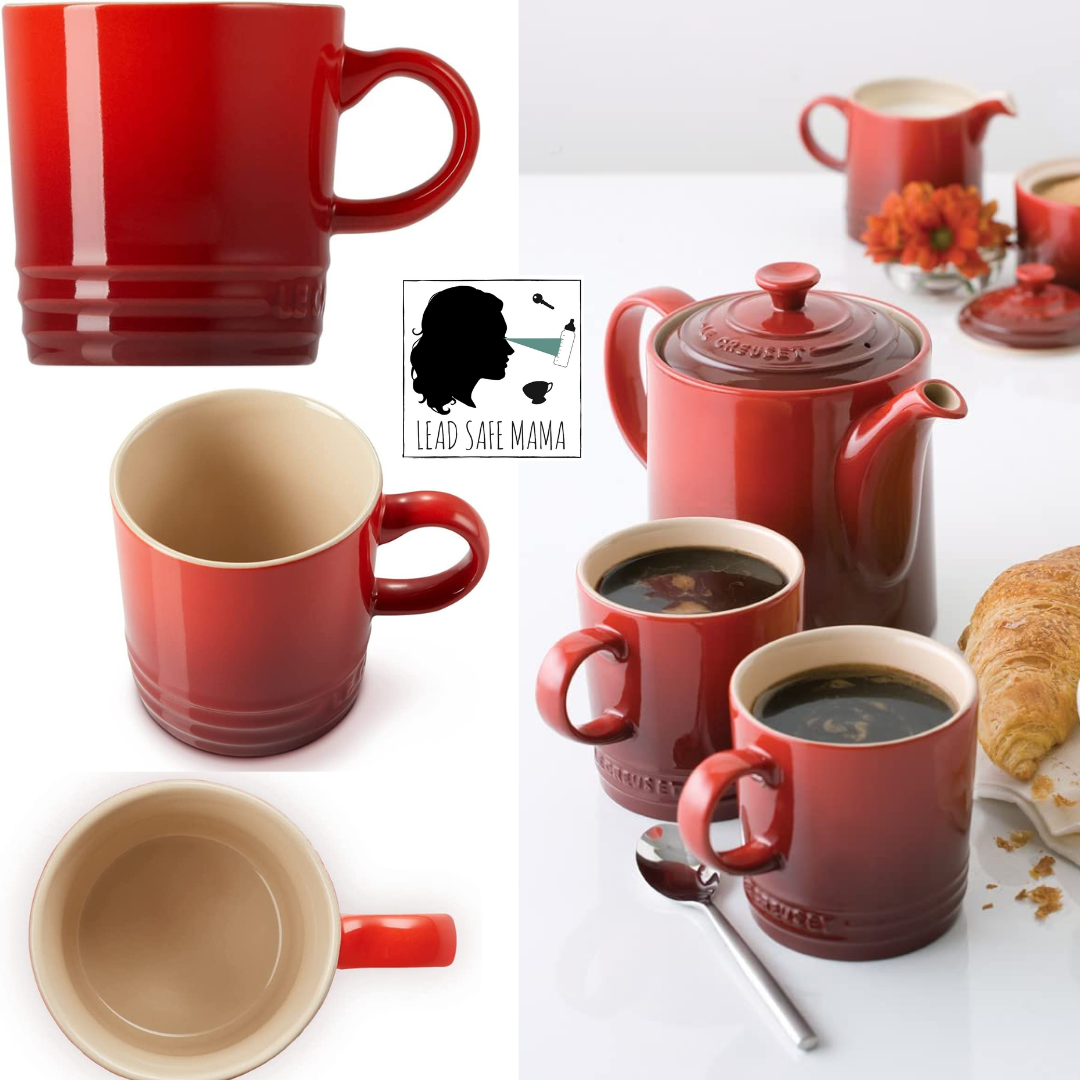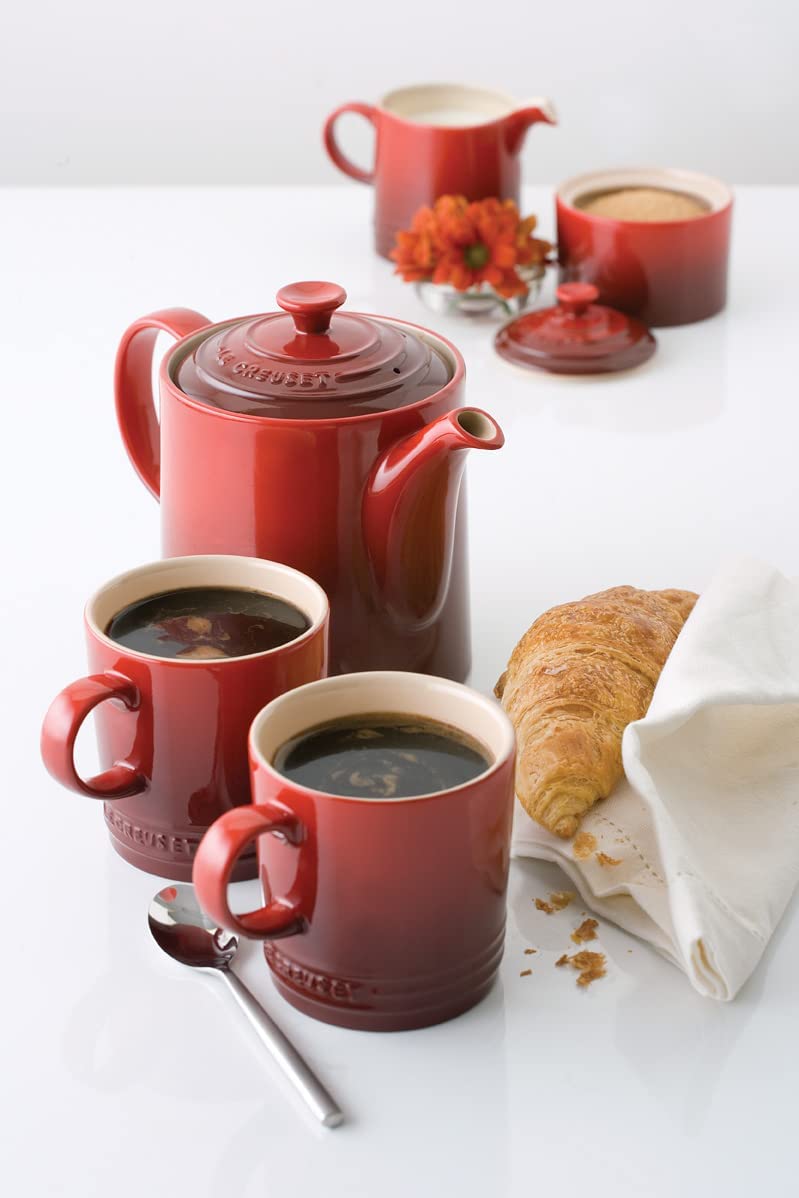XRF test results for brand new Le Creuset red (“Cerise”) glazed stoneware espresso mug: Positive for Lead & Cadmium (a known carcinogen)
January 2, 2023 — Monday
With contributions made by Lead Safe Mama readers (thank you, friends!), I just purchased this little cup (“3 oz Stoneware Espresso Mug“) new (off of Amazon, from the Le Creuset Amazon store — link) to demonstrate to myself (and Lead Safe Mama readers) that the brand Le Creuset is still (today) unethical in their materials sourcing. They are currently still using high-cadmium-content pigments in the decorative glazes of their ceramic pieces. Cadmium is a known carcinogen (it is well-established that cadmium is causally linked to cancer, in both human and animal studies).
How much Cadmium is “too much Cadmium”?
- The amount of Cadmium in consumer goods that is considered unsafe (and illegal) in the country of Denmark is 75 ppm Cadmium or higher.
- While there are some federal regulatory standards and guidelines limiting Cadmium in specific subsets of consumer goods (children’s jewelry, some food products, etc.), there is currently no nationwide (i.e. Federal) comprehensive regulatory standard here in the U.S. limiting Cadmium in consumer goods across the board.
- However, in the State of Washington, it is regulated — with the legal limit set at 40 ppm Cadmium for consumer goods used by children (including dishware).
While I am certain that Le Creuset does leach-testing to confirm the safety of their products (ensuring they are safe when they are first manufactured and sold), the concern is not just a potential future concern (for possible health impacts to the user — if and when the glaze on this cup deteriorates with use over time), but also a concern for the pollution of our planet, and the health and well being of the workers. This is especially true for the people who risk significant exposure to this toxic metal when they mine and refine the Cadmium for pigments to use in these brightly colored (normally Red, Orange, and Yellow) glazes.
In addition to the red exterior of this tiny mug (Le Creuset’s “Cerise” color) testing positive for extremely high levels of Cadmium (over 1,900 ppm), the cream-colored interior of the cup also tested positive for trace levels of Lead and Cadmium (levels considered safe by all standards — but which indicate that there is likely cross-contamination from the pigments in the glazes Le Creuset uses for the exterior of their vessels to the glazes they use for the interior (food contact surfaces) of these vessels). Such a shame — because these little mugs are really cute — and so I can see someone buying them for a child in their life to use!
Full XRF test results are below. Here is a link to this product on Amazon, so you can see it in the wild (not so you can purchase it — we do not recommend purchasing this product or ANYTHING from this brand!).
For context, please read these background articles
- The concern for toxicants found in the glaze of pottery.
- The concern for toxic glazes — even if they are “just on the outside.”
- An overview of Cadmium limits for items intended for use by children.
- An overview of people using espresso cups for their children (and why that should not be done).
- The Espresso Cup category of articles on the site (there’s a Lead-free option in there!).
- A direct link to the Le Creuset category of articles here on this website.
Metals highlighted in red are generally considered toxic.
Metals highlighted in blue are not considered toxic in this application.
Reading #1) Cream Interior of cup
60-second reading
- Lead (Pb): 62 +/- 13 ppm
- Cadmium (Cd); 11 +/ 6 ppm
- Tin (Sn): 19 +/- 10 ppm
- Mercury (Hg): non-detect
- Selenium (Se): non-detect
- Barium (Ba); 114 +/- 36 ppm
- Chromium (Cr): non-detect
- Antimony (Sb): non-detect
- Copper (Cu); 240 +/- 39 ppm
- Zinc (Zn): 1,964 +/- 82 ppm
- Zirconium (Zr): 7,462 +/- 177 ppm
- Iron (Fe): 2,026 +/- 181 ppm
- Platinum (Pt): 144 +/- 44 ppm
- Bismuth (Bi): 67 +/- 13 ppm
- No other metals were detected in consumer goods mode.
Reading #2) Red “Cerise” exterior of the cup
60-second reading
- Lead (Pb): non-detect
- Cadmium (Cd): 1,987 +/ 99 ppm
- Tin (Sn): non-detect
- Mercury (Hg): non-detect
- Selenium (Se): 1,201 +/- 58 ppm
- Barium (Ba): 258 +/- 76 ppm
- Chromium (Cr): 1,659 +/- 465 ppm
- Antimony (Sb): non-detect
- Nickel (Ni): 616 +/- 120 ppm
- Copper (Cu): 515 +/- 69 ppm
- Zinc (Zn): 3,354 +/- 149 ppm
- Zirconium (Zr): 34,400 +/- 1,100 ppm
- Niobium (Nb): 206 +/- 29 ppm
- Iron (Fe): 2,629 +/- 269 ppm
- Platinum (Pt): 297 +/- 71 ppm
- Cobalt (Co): 2,824 +/- 216 ppm
- Bismuth (Bi): 43 +/- 21 ppm
- No other metals were detected in consumer goods mode.
Amazon links are affiliate links. If you purchase something (anything — not just the item we link to) after clicking on one of our Amazon affiliate links, we may receive a percentage of what you spend at no extra cost to you.
For those new to this website:
Tamara Rubin is a multiple-federal-award-winning independent advocate for childhood Lead-poisoning prevention and consumer goods safety and a documentary filmmaker. She is also a mother of Lead-poisoned children (two of her sons were acutely Lead-poisoned in 2005). Since 2009, Tamara has been using XRF technology (a scientific method used by the U.S. Consumer Product Safety Commission) to test consumer goods for toxicants (specifically heavy metals — including Lead, Cadmium, Mercury, Antimony, and Arsenic). All test results reported on this website are science-based, accurate, and replicable. Items are tested multiple times to confirm the test results for each component tested. Tamara’s work was featured in Consumer Reports Magazine in February 2023 (March 2023 print edition).
Never Miss an Important Article Again!
Join our Email List














Is it the same for the cream and sugar vessels in the photo? I have the matte black ones like that.
It’s for these two colors of glazes.
T
I have white Le Creuset with white interior. Both have tiny little eggshell cracks on the inside but none of the pieces are broken off. Please let me know if this is a concern I use them daily and have small children who eat out of them daily. Thank you!
Interested in learning about hand held lead detection products, (like one you used in movie). Thank you.
I google where this brand is manufactured. They said still in France “just like the last 100 years…”. However, Amazon descriptions say Thailand and China. It’s no wonder they test positive!
I had no idea about this and Le Creuset; it’s truly sad. I have spent thousands of dollars over the years collecting LC pieces. All our dinnerware is cobalt color, and everything else is cerise. Teakettle, gravy boat, 2 Dutch Ovens, bakeware, serving dishes, casserole dishes, and the list goes on. The only pieces stamped “France” are the Dutch Ovens. Would you consider those safe to use? Everything else is stamped China. No wonder the company has replaced some of my products when there was chipping or scratching on the dinnerware. I am waiting for a response from them about my concern for everything else I have purchased.
Do you have any suggestions for mugs that do not contain heavy metals? I’ve been using Le Creuset 14 oz mugs with the beige interior (palm, flame) and also the white mugs, for decades and didn’t know this. I always trusted they were the best quality with very stable glazes. So what mugs are safe? Thanks!